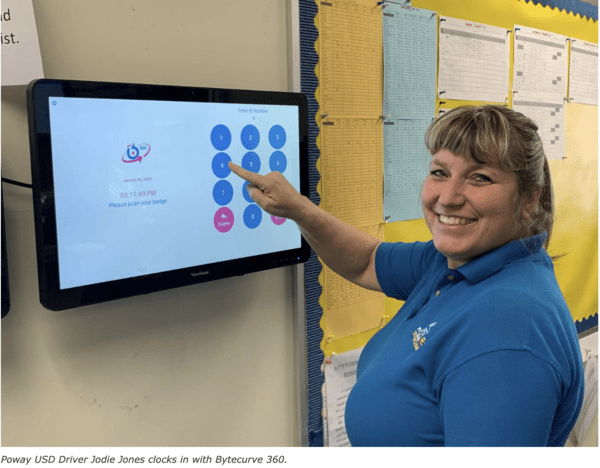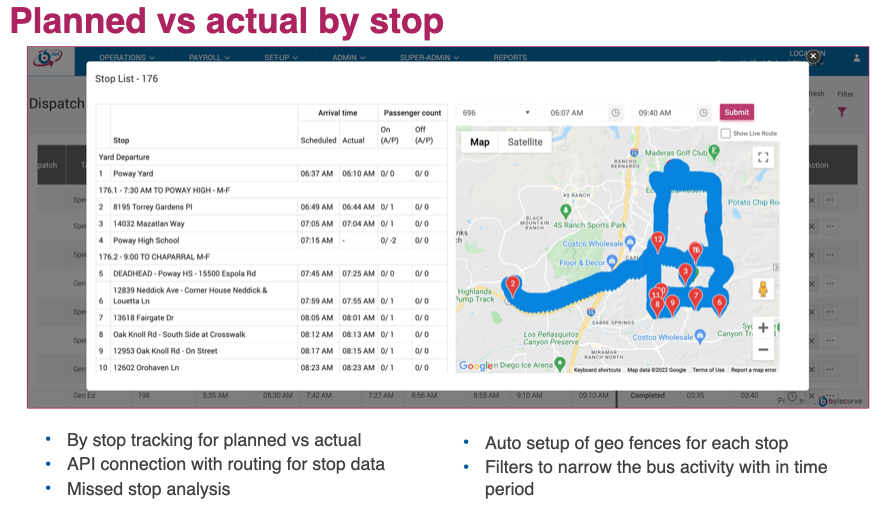Our School Bus Operating platform arms your team with the information they need to improve decision making around safety, reducing costs, and being more efficient each day.
Trusted by dozens of public and private student transportation fleets to improve how they do business.

Trusted by the Finest Names in School Bus Transportation
Four-Day School Weeks: A Growing Trend with Mixed Reactions
While far from a widespread trend, the four-day school week is nevertheless rising in prominence and raising a new crop of opportunities and threats for school districts and all of the associated stakeholders.
The four-day school week will undoubtedly have an impact on transportation departments, and school bus operations in a district with a 20% reduction in in-person instruction will undoubtedly change.
This article will explore the trend, unpack the benefits and challenges, which are stark depending on the constituency, and introduce how student transportation departments will be impacted.
Community Response: A Balancing Act
The move to a four-day week has garnered mixed reactions from parents and communities.
While some welcome the prospect of a longer weekend for their children and themselves, others worry about the potential impact on learning and childcare needs.
Working parents, in particular, may face challenges finding reliable and affordable childcare for the extra day off.
Urban and rural districts where parents already face a host of challenges related to before and after-school care, teacher pay, and community support face an especially challenging terrain when navigating the move to a four-day school week.
There isn’t a widespread adoption of four-day school weeks yet, so there’s limited data on how working parents have universally coped.
However, here’s a breakdown of the challenges and potential coping mechanisms:
Challenges:
- Childcare: The biggest hurdle is likely finding childcare for the extra day off. This can be expensive, especially for families with multiple children. Finding reliable and safe options on short notice can be stressful and sometimes outright impossible.
- Work Schedule Conflicts: Juggling work schedules with an extra day off can be tough. Parents who can’t take a day off or work flexible hours may have to rely on family, friends, or expensive last-minute childcare solutions.
- Disrupted Routines: A change in the school schedule can disrupt established family routines, making mornings and evenings more chaotic, especially with younger children who might need more supervision on their off day.
Coping mechanisms for parents impacted by the four-day school week:
- Family and Friends: Parents might rely on grandparents, siblings, or close friends to help out with childcare on the extra day.
- Before/After School Programs: Some schools might extend before and after school programs to provide some childcare coverage, though affordability might be a concern.
- Community Programs: Community centers or YMCA-type programs might offer childcare options, although availability and cost could be factors.
- Flexible Work Arrangements: Ideally, employers who have a workforce with children might be open to flexible work schedules or compressed workweeks to accommodate the change.
It’s important to note that these are just potential strategies, and the success of a four-day week for working parents depends on a number of factors, including:
- The availability and affordability of childcare options
- The flexibility of parents’ work schedules
- The resources offered by the school district, such as extended before/after school programs,.
- The overall support system within the community.

Bytecurve360 delivers a transformative operational experience.
Some of the most essential features include:
- Better Driver communications so that employees can check in/out remotely, view their schedules and receive messages on their smartphones.
- Easier payroll management so that you no longer have to manually calculate employee guarantees/contracts and overtime.
- Simpler management of daily operations, including assigning/reassigning drivers and vehicles, using real-time integration with GPS and routing systems. This allows all stops to be easily be rerouted when a bus breaks down or a driver can’t come in.
School Buses Navigate a New Terrain
The shift to a four-day week presents a unique challenge for school transportation departments.
They must now grapple with how to adjust bus routes and schedules to accommodate the compressed school week.
Several approaches are emerging:
- Extended School Days: Some districts lengthen the remaining four school days to maintain the same instructional time. This might necessitate adjusting bus pick-up and drop-off times, and will certainly include changes to routes and the routing process
- Staggered Schedules: Another option involves staggering school start and end times across different grade levels. This reduces the number of buses needed on the road at any given time but creates a more complex logistical puzzle. This process is widely adopted today and helps explain why some middle school students start school before sunrise while high school students may begin a full two hours later
- Targeted Transportation: For students who live far from school or participate in after-school activities, districts might offer targeted transportation options on the non-school day.
Examples and Cost Savings
Here are a few specific examples of districts adopting the four-day week and their reported cost savings:
- Holly, Colorado: Citing teacher burnout and a need to cut costs, the Holly School District in Colorado transitioned to a four-day week in 2010. The district reported saving around $130,000 annually on transportation costs alone due to reduced fuel consumption and maintenance needs for buses.
- Okemah, Oklahoma: Facing a shrinking student population, the Okemah School District in Oklahoma implemented a four-day week in 2018. The district estimates annual savings of over $100,000, including $40,000 in transportation costs.
- The Bandera Independent School District: in the San Antonio area approved the transition on Monday, local news station KENS reported.
- Natalia, Utopia and La Vernia ISDs (all in Texas) have shifted to four-day weeks
Some perceive that if the school week is reduced by one day, or 20 percent, school expenses will also be reduced by 20 percent.
Reality does not support this assumption.
When a school or district adopts a four-day week, it adjusts staff schedules so that each employee continues to work the same number of hours over a four-day period instead of five days.
According to research conducted by the Education Commission of the States:
- The average district could produce a maximum savings of 5.43 percent of its total budget by moving to a four-day week.
- Districts that moved to a four-day week have experienced actual savings of only between 0.4 percent and 2.5 percent.
The Road Ahead
The long-term impact of the four-day school week on student achievement and overall well-being remains to be seen.
School districts are carefully monitoring student performance and gathering feedback from parents and educators.
Transportation departments are also playing a crucial role in ensuring a smooth transition for students and families.
As this trend continues to grow, it will be essential to find creative solutions that address the logistical challenges and prioritize the needs of students, educators, and families alike.
Whether students are on a four- or five-day schedule, bus operations will continue to be central to delivering education in every community. Public and private fleets are implementing Bytecurve360, a rapidly expanding technology, to enhance the transportation experience for students.
Based in suburban Chicago with dozens of fleet customers that include approximately 40,000 buses, Bytecurve is the only software solution serving the school bus industry that connects the two most common technologies leveraged by districts: routing and GPS tracking.
By merging these solutions into its proprietary 360 view, Bytecurve clients improve their ability to deliver students safely and on time to their destination while better managing their payroll.
Bytecurve can help pupil transportation leaders overcome many of the common challenges they face across the country, including:
- Staffing shortages: A chronic, nationwide shortage of school bus drivers challenges school districts to provide adequate transportation for students. Regular absenteeism also presents challenges. Bytecurve can help by connecting drivers to fleet management for real-time adjustments driven by not having enough drivers
- Funding constraints: School districts face budget constraints, although COVID-19 relief funding by the federal and state governments has allowed many districts to invest in technologies they need to perform better. Bytecurve can be part of that investment to deliver improved services
- Technology challenges: Implementing new technologies, such as GPS tracking and routing software, which can help improve the efficiency and safety of student transportation, presents challenges to districts. Bytecurve provides white-glove implementation services and robust ongoing support, often helping districts not only with the 360 solution but also get more out of their existing investments.
- Compliance with regulations: School districts must comply with a variety of federal and state regulations, which can add to the administrative burden of providing student transportation. Bytecurve’s in-house expertise consists of student transportation experts who can share best practices from other districts and fleets.
- Safety concerns: Student transportation is a high-risk activity, and school districts must take steps to ensure the safety of students and drivers. Bytecurve’s dispatch solutions decrease the likelihood that students are left outside waiting for a late bus thanks to its ability to reassign routes and drivers in seconds.
Bytecurve can play a pivotal role in addressing virtually every major challenge that the student transportation industry faces.
School districts committed to safety, efficiency, and reliability will find a committed partner in Bytecurve and its suite of solutions.
Integrated Student Transportation Software

If you are in the market for a school bus driver scheduling software, here’s what to look out for
- The application should feature a user-friendly design to enable administrators, drivers, and parents to understand and navigate the system. It should be cloud-based and be supported by U.S.-based support team who appreciate the unique demanding environment of a school bus fleet.
- The platform should include ongoing and comprehensive training and support for all users to guarantee they’re comfortable with the tool and can use it effectively. Bytecurve features ongoing support from our team of school bus operations experts.
- The school bus driver scheduling software platform you eventually select should commit to continuous updates and maintenance to ensure it remains current and devoid of bugs or glitches. Bytecurve is founded by innovators who will never stop improving the platform based on the needs and wants of their customers and school bus fleet operators.
- The app should be flexible and customizable to tailor it to the unique needs of each school or district. Bytecurve will work with each district or contract to build their tailored solution that meets their unique requirements.
- The software should be capable of integrating with other related tools like student information systems to guarantee accurate and up-to-date data is being used to create and manage driver schedules. Bytecurve has integrations with all of the major routing and GPS fleet tracking solutions so that virtually any school bus fleet can enjoy the benefits of the transformative technology.

Secure
Only authorized employees will be able to access DriveOn based on a customer specific access code. This code can be turned off as needed by an authorized administrator.

User friendly
DriveOn is easy to use with a simple, smart interface.
Available on both iOS and Google Play stores.













